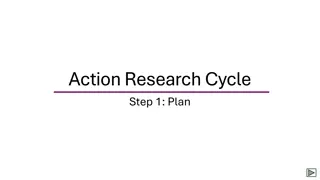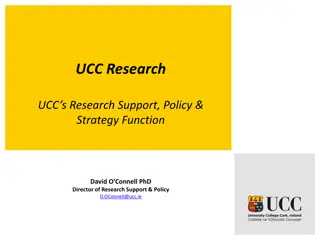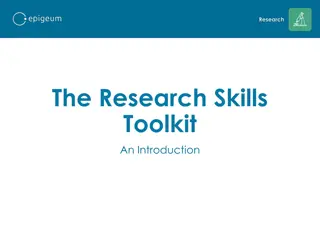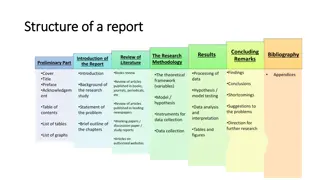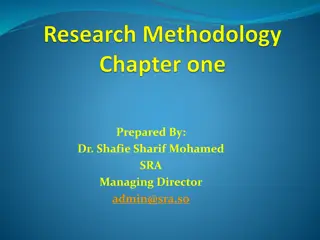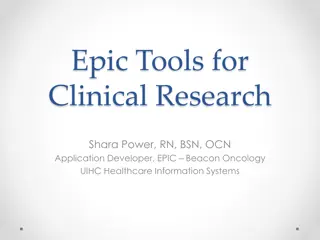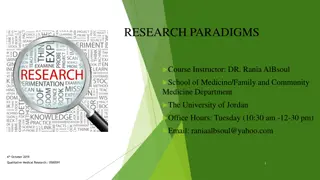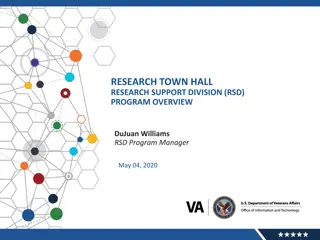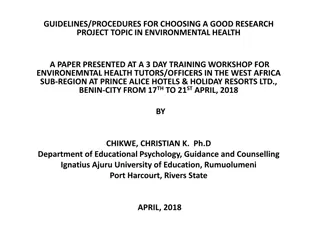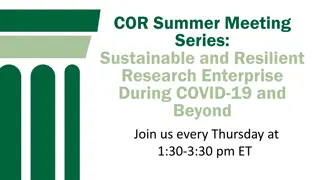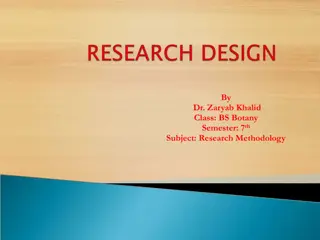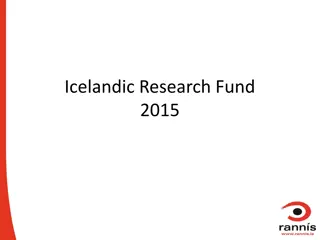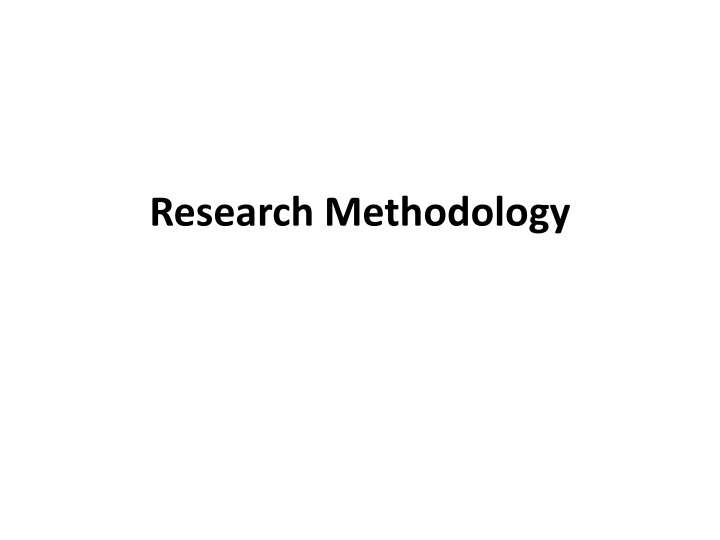
Understanding Research Methodology in Business Studies
Explore the significance of research in business, from defining its purposes to its systematic approach in obtaining and confirming new knowledge. Learn why studying business research is essential for guiding managerial decisions and improving organizational performance. Discover the systematic and objective aspects of business research and the importance of well-designed research with potential applications.
Download Presentation

Please find below an Image/Link to download the presentation.
The content on the website is provided AS IS for your information and personal use only. It may not be sold, licensed, or shared on other websites without obtaining consent from the author. If you encounter any issues during the download, it is possible that the publisher has removed the file from their server.
You are allowed to download the files provided on this website for personal or commercial use, subject to the condition that they are used lawfully. All files are the property of their respective owners.
The content on the website is provided AS IS for your information and personal use only. It may not be sold, licensed, or shared on other websites without obtaining consent from the author.
E N D
Presentation Transcript
RESEARCH Meaning of research Research is the systematic approach to obtaining and confirming new and reliable knowledge It is a scientific & systematic investigation and contribution of new facts to the existing range/ stock of knowledge in any branch. Thus, it is a systematic quest(search) of solution to a problem. finding effective
Defining research Research is systematic inquiry to describe, explain, predict and control the observed phenomenon -Earl Robert Search for knowledge through systematic and objective method of finding solution to a problem. Detailed and careful study of something to find out more information of it.
Why we study Business research ? Business research is a systematic inquiry that provides information to guide managerial decisions. More specifically, it is a process of planning, acquiring, analyzing, and publishing relevant data, information, and insights to decision makers in ways organization to take appropriate actions which in turn, performance. that mobilize the maximize Business
Business research The systematic and objective identification, collection, analysis, distribution, and use of information for the purpose of assisting management in decision making related to the identification and solution of problems. Systematic Objective Identify Collection of Information Analyze Interpret Draw inferences Present the information
Research is 1. Searching for explanation of events, phenomena, relationships and causes What, how and why things occur Are there any interactions? 2. A process Planned and managed to make the information generated credible Creative process It is circular always leads to more questions 6
All well designed and conducted research has potential application. Failure to see applications can be due to: Users not trained or experienced in the specialized methods of economic research and reasoning. Researchers often do not provide adequate interpretations and guidance on applications of the research. 7
Research is not Accidental discovery : 1. Accidental discovery may occur in structured research process 2. Usually takes the form of a phenomenon not previously noticed 8
Research is not cont. Data Collection an intermediate step to gain reliable knowledge collecting reliable data is part of the research process 9
Research is not cont. Searching out published research results in libraries (or the internet) This is an important early step of research. The research process synthesis and analysis. But, just reviewing of literature is not research. always includes 10
Objectives of research Quest of truth. Exploration of new ideas and concepts. LOD Understand what is observed. Understand cause and effect relationship. Improve methods and techniques (SPSS, Matlab, EVIEWS) Hypothesis testing.
Types of scientific method Deductive method Inductive method Abductive method Historical method Comparative method Structural method Functional method
Steps in Research Process Select area of investigation( problems) Review of literature Formulate hypothesis Design study to test hypothesis Conduct study( data collection) Analyze result (data analysis) Do result support hypothesis If yes- report If no- develop alternative explanation
Research Areas in Management (Scope) SEGMENTATION RESEARCH PRODUCT RESEARCH Test concept Determine the basis of segmentation Determine optimal product design Establish market potential and responsiveness for various segments Package tests Select target markets Product modification Create lifestyle profiles: demography, media, and product image characteristics Brand positioning and repositioning Test marketing
PROMOTIONAL RESEARCH Optimal promotional budget 0.00% APR Sales promotion relationship Optimal promotional mix Copy decisions Media decisions Creative advertising testing Evaluation of advertising effectiveness Claim substantiation PRICING RESEARCH Pricing policies Importance of price in brand selection Product line pricing $ALE Price elasticity of demand Initiating and responding to price changes
DISTRIBUTION RESEARCH Determine Types of distribution Attitudes of channel members Intensity of wholesale & resale coverage Channel margins Location of retail and wholesale outlets
Personnel Manpower Planning Performance appraisal systems Conflict management Design of incentive plans Leadership styles. Training methods Change Management. Job satisfaction. Etc.
Finance Financial performance . Cost analysis model Portfolio management. Break- even analysis. Working Capital management model. Economic growth models. Etc.
Production Forecasting Inventory control Master production scheduling. Quality control Work design. Maintenance management. Method study. Flow and job shop scheduling etc.
Part II Research Design
Research Design- Definition Research Design is the framework or blueprint to conduct the research project. It details the procedure necessary for obtaining the information needed to structure or solve research problems.
Components of research design Define the information needed Design the exploratory/descriptive and/or Causal phases of the research Specify the measurement and scaling procedures Construct and pretest a questionnaire or an appropriate form of data collection Specify the sampling procedure and sample size Develop a plan of data analysis
Classification of research design Research Design Exploratory Conclusive Descriptive research Causal Research Cross-sectional design Longitudinal design Single Cross sectional design Multiple-cross sectional design
Exploratory research Primary objective is to explore or search through a problem or situation to provide insights into a problem confronting the researcher. Used in situation when researcher does not have enough understanding to proceed with the research project. May not follow formal research protocols and procedures. Mainly used to: Formulate a problem or define a problem more precisely Identify alternative courses of action. Develop Hypotheses. Isolate key variables and relationships for further examination. Gain insights for developing an approach to a problem. Establish priorities for further research. Methods generally adopted: Survey of experts Pilot surveys Analysis of secondary data Qualitative research
Conclusive Research To test specific hypotheses and examine specific relationships. More formal and structured. Based on data drawn from large sample, and the data obtained are subject to quantitative analysis. Findings are conclusive in nature. Of two types: Descriptive and Causal.
Comparison b/w Exploratory and Conclusive research Exploratory Conclusive Objective To provide insights and understanding To test specific hypotheses and examine relationships Characteristics Information needed is defined only loosely Information needed is clearly defined Research process is flexible and unstructured Research process is formal and structured Sample is small and non- representative Sample is large and representative Analysis of primary data is qualitative Data Analysis is quantitative Findings/Results Tentative Conclusive Outcome Generally followed by further exploratory or conclusive research Findings used as inputs into decision making
Descriptive Research To describe something usually market characteristics or functions. Prior formulation of specific hypotheses. Pre-planned and structured method. Clear specification of Who, What, When, Where, Why and Way (the six W s) of research. Mainly used to: Describe the characteristics of relevant groups To estimate the percentage of units in a specified population exhibiting a certain behaviour To determine the perceptions To determine the degree to which variables are associated To make specific predictions Methods used: Secondary data Surveys Panels Observational and other data Of two types: Cross sectional and longitudinal designs
Cross sectional designs Collection of information from any given sample of population only once. Single Cross sectional design: One sample from the target population and information is obtained only once. Multiple Cross sectional designs: Two or more samples of respondents and information from each sample is drawn only once.
Suggest a suitable research design How did the Americans rate the performance of Obama immediately after his second term? How did the American people change their view of Obama s performance during his presidency?
Causal Research To determine cause and effect relationships. To understand which cause(independent variables) and which are the effect(dependent variables) of a phenomenon. To determine the nature of relationships between dependent and independent variables. Main method used is experimentation, where causal or independent variables are manipulated in a very controlled environment. variables are the
Comparison of Basic Research Designs Exploratory Descriptive Causal Objective Discovery of new ideas and insights Describe market characteristics or functions Determine cause and effect relationships Characteristics Flexible, versatile Marked by the prior formulation of specific hypotheses Manipulation of one or more independent variables Often the front end of other research designs Preplanned and structured designs Control of other mediating variables Methods Expert surveys Secondary Data Experiments Pilot Surveys Surveys Secondary Data Panels Qualitative research Observational and other data
A Classification of Applied Research Applied Research Problem Solving Research Problem Identification Research Segmentation Research Product Research Promotion Research Distribution Research Job satisfaction research Market Potential Research Market Share Research Market Characteristics Research Sales Analysis Research Forecasting Research Business Trends Research
JARGONS AND TERMINOLOGY CONCEPTS AND OVERVIEW VARIABLES : In practice , the term variable is used as a synonym for construct or the property being studied. In this context, a variable is a symbol of an event, act, characteristics, trait, or attribute that can be measured and to which we assign categorical values. For purpose of Data entry and analysis, we assign numerical value to a variable based on the variable s properties. RANDOM VARIABLES : A variable is random if it takes on different values as a result of the outcomes of a random experiment. The values of the random variable are the numerical values corresponding to each possible outcome of the random experiment. Types of Random variables Continuous Dichotomous Discrete
Dichotomous variables : It takes on only two values, reflecting the presence and absence of a property. The values are generally represented by 0 & 1. For ex. Male or Female. Discrete variables : If a random variable is allowed to take only a limited number of values is called discrete random variable. Continuous variable : If a random variable is allowed to assume any value within a given range or in some cases , an infinite set , it is a continuous random variable. Independent and Dependent Variable : If one variable depends upon or is a consequence of the other variable is termed as dependent variable, and the variable that is antecedent to the dependent variable is termed as independent variable. Independent variable a.k.a Predictor, Presumed cause, Stimulus, Antecedent, Manipulated. Dependent variable a.k.a Criterion, Presumed effect, Respond, Consequence, Measured outcome. Moderating Variables (MV) : It is a second independent variable which has got significant or contingent effect on the originally stated IV-DV relationship. For ex. Commission based compensation (IV) will lead to increased sales productivity (DV) per worker, especially among younger workers (MV).
Extraneous Variables (EV): Variables other than the independent variables , that influence the dependent variables are termed as extraneous variables. Intervening variables (IVV) : An intervening variable is a conceptual mechanism through which IV and MV might affect the DV. IVV may be defined as that factor which theoretically affects the observed phenomenon but cannot be seen, measured, or manipulated; its effect must be inferred from the effects of the independent and moderate variables on the observed phenomenon. In the case of compensation hypothesis, one might view the intervening variable to be job satisfaction. An example illustrating the relationships among the above stated variables. A promotional campaign (IV) will increase savings activity (DV) , especially when free prizes are offered (MV) , but chiefly among small savers (EV-control). The results come from enhancing the motivation to save (IVV).
Propositions and Hypothesis Proposition is defined as a statement about observable phenomena (concepts) that may be judged as true or false. When a proposition is formulated for empirical testing , it is called hypothesis. A hypothesis is an unproven statement or proposition about a factor or phenomenon that is of interest to the researcher. Hypotheses also described as proposition in which variables are assigned to cases. A Case is defined as the entity or thing the hypothesis talks about. For example: In Durgapur (case) Colgate toothpaste is the most preferred (variable) brand. Also, In W.B (cases) Colgate toothpaste is the most preferred (variable) brand
Descriptive Hypothesis : It states the existence, size, form, or distribution of some variable. For ex. 70% of high school educated males (cases) are unemployed (variable) Relational Hypotheses : These are statements that describe a relationship between two variables with respect to some case. For ex. Foreign brands (variable) are perceived to be of better quality (variable) by Indian (case) than the indigenous brands.
Correlational Hypotheses : It states that the variables occur together in some specified manner without implying that one causes the other. For ex. The people of Durgapur prefer eating fast food than Asansol. Explanatory (causal) hypotheses : There is an implication that the existence of or a change in one variable causes or leads to a change in the other variable. For ex. An increase in disposable income leads to the growth of entertainment industry.
ROLE OF THE HYPOTHESIS It guides the direction of the study. It identifies facts that are relevant. It suggests the appropriate form of research design. It provides a framework for organizing the conclusions. FEATURES OF A STRONG HYPOTHESIS Adequate for its purpose. Testable Better than its rivals.
Types of Data 1) Primary Data There are broadly two types of Data 2) Secondary Data Primary Data : Data originated by the researcher for the specific purpose of addressing the research problem. Secondary Data : Data collected for some purposes other than the problems at hand. For ex. A a retail mart wants to find out the criteria used by the households to select departmental stores. The secondary data can be obtained from Marketing Journals (Journal of Retailing, Journal of Marketing Research etc.) A COMPARISON OF PRIMARY AND SECONDARY DATA Primary Data Collection purpose For the problems at hand not at hand Collection process very involved Collection cost High Collection Time Long Secondary Data rapid and easy Low Short
Primary Data : There are two types of primary data. 1) Qualitative Data 2) Quantitative Data Quantitative Data A) Descriptive B) Causal Observational And other data Experimental Data Survey Data Secondary Data : There are two types of secondary Data 1) Internal 2) External Internal Data (Types) Ready to use Requires further processing External Data (Types) Published materials Computerized database Syndicated services
RESEARCH PROCESS Step 1. Problem Definition Discover the management dilemma Define the management question Define the research question Refine the research questions Step-2. Research Proposal Step-3. Development of an Approach to the problems Formulating an objective/theoretical framework. Developing an analytical models, research questions, and hypothesis Step-4. Research design formulation. Data collection design Sampling design. Instrument development and pilot testing Step-5. Data collection and preparation Step-6. Data preparation and analysis. Step-7. Report preparation and presentation. Step-8. Management Decision.
Problem Formulation / Definition Problem definition is A broad statement of the general problem and identification of the specific components of the research problem. It allows researcher to obtain all the information needed to address the management decision problem. It guides the researcher in proceeding with the projects. Broad statement : It is the initial statement of the research problem that provides an appropriate perspective of the problem. Specific components : It focuses on the key aspects of the problem and provide clear guidelines on how to proceed further. Management decision problem Should a new product be introduced ? Should the Ad. Campaign be changed ? Research problem To determine consumer preferences and purchase intentions for the proposed new product. Determining the effectiveness of the current Ad. campaign
1) 2) 3) 4) 5) 1) 2) 3) 4) 6) Tasks Involved in defining the Problem Discussions with Decision Maker (s) Interview with the experts. Secondary Data analysis. Literature Review. Qualitative Research. Environmental context to the problems Factors having impact on the definition of the Research Problems. Past information and forecasts. Resources and constraints. Objectives Test unit property/Buyer Behaviour Economic Environment 7) Technological skills. LITERATURE REVIEW Literature review is the systematic study of scholarly articles, publications, scant literature for getting the relevant data and trends from the previous research. It also generates the need for proposed research work by appraising the shortcomings or information gaps in secondary data sources. 5) Legal Environment
Summary of the Beginning Stages of Marketing Research Sales are not picking up for a new product/brand Symptom of Marketing Problem Exploratory Research Initial understanding of Possible Causes of the Problem The brand has an image problem How can we improve the brand s image? Marketing Decision Problem See next slide Formulation of Research Problem See next slide Statement of Research Objectives
Summary of the Beginning Stages of Marketing Research - Continued Research Questions: Research Objectives 1) What is the current image of our brand compared to competitors brands? 1) To determine our brand s image compared to competitors brands. 2) What is the role of our price, packaging, distribution, advertising, etc on the current image of our brand? 2) To determine the source of our current image problems. 3) To examine the specific role of packaging in the present image of our brand. 3) Will a change in packaging lead to a positive change in image?
RESEARCH PROPOSAL Once the research gap is established by defining the problem, the research proposal is made. Research proposal is a written document which suggests the projects purpose and the proposed methods of investigation. Time and budgets, responsibilities and obligations are spelled out. DEVELOPMENT OF AN APPROACH TO THE PROBLEM Components of the approach : 1. Objective /Theoretical Framework. 2. Analytical Model . a. Verbal Model b. Graphical Model c. Mathematical Model 3. Research Questions (RQ) 4. Hypotheses. 5. Specification of Information needed. Objective/theoretical Framework : Research should be based on objective evidence and supported by theory. Objective evidence is gathered by compiling relevant findings from secondary sources. Theory is a conceptual scheme based on foundational statements called axiom, which are assumed to be true. The researcher should rely on theory to determine which variables should be
Analytical Model : It is a set of variables and their interrelationship designed to represent , in whole or in part, some real system and process. Verbal Model : The variables and their relationships are stated in prose form. Graphical Model : It is visual and used to isolate variables and to suggest directions of relationships. Mathematical Model : Explicitly specify the relationships among variables, usually in equation form. EXAMPLE OF MODEL BUILDING Objective : Analyzing the key factors for a Retail store patronage/ Loyalty. Verbal Model : A consumer first becomes aware of the retail store. That person then gains an understanding of the store by evaluating in terms of the factors comprising choice criteria. Based on the evaluation, the consumer forms a degree of preference for the store. If preference enough, the consumer will patronize the store.
Graphical Model Patronage Preference Understanding : Evaluation Mathematical model n y = a0+ ai +xi i=1 Where, y = Degree of preference a0 , ai = Model parameters to be examined statistically. xi = Store patronage factors that constitute the choice criteria. Awareness
Research Questions (RQs) Research questions are refined statements of the specific components of the problem. The formulation of research questions are not only guided by the problem definition , but also the theoretical framework and the analytical model adopted . Development of Research questions and hypothesis Objective / Theoretical framework Analytical Model For Ex. : RQ : Do customers of Big Bazaar exhibit store loyalty ? H : Customers of Big Bazaar are loyal. Specification of Information needed By focusing on each component of the problem and the analytical framework, models, RQs, Hypothesis; researcher can determine what information is required to carry out the research project. Components of the problem Research questions Hypothesis




